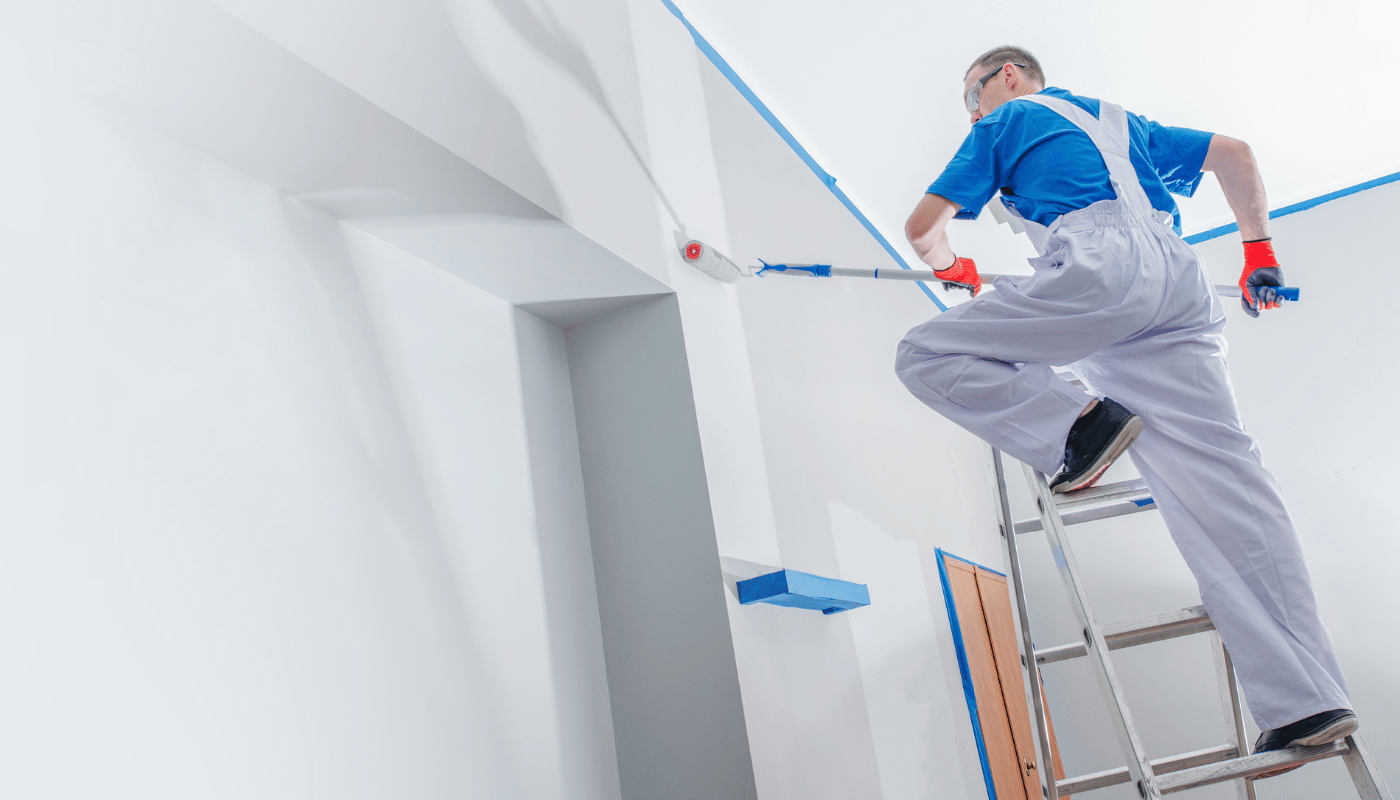Interior Paint. What should I use?

Choosing the right interior paint can transform your space from mundane to magnificent, but with so many options, how do you decide which is right for you?
Whether you're a first-time homeowner or looking to revamp your space, this comprehensive guide will walk you through the essential aspects of selecting interior paint.
Understanding Paint Types
Oil-Based vs. Water-Based
The fundamental division in interior paints lies between oil-based and water-based formulas, each with its unique advantages. Oil-based paints, known for their durability and smooth finish, have long been a go-to choice for high-traffic areas. However, they require mineral spirits for cleanup and have a longer drying time.
Conversely, water-based paints, also referred to as latex paints, have gained popularity for their ease of use, quick drying times, and eco-friendlier profile.
When choosing between these two, consider factors like ventilation, drying time, and the surface you're painting.
Finishes and Sheens
From matte to high-gloss, understanding paint finishes is key to achieving the desired aesthetic and functionality.
Matte or flat finishes offer a non-reflective look, perfect for hiding imperfections on walls.
However, they are less durable and harder to clean.
On the other end of the spectrum, high-gloss finishes are highly durable and easy to clean, making them ideal for kitchens, bathrooms, and trim.
In between, you have eggshell, satin, and semi-gloss, offering various degrees of sheen and practicality.
The choice depends on your desired look and the room's functionality.
Room by Room Guide
Kitchens and Bathrooms
High moisture and frequent cleaning make kitchens and bathrooms special cases in paint selection.
For these areas, durability and resistance to humidity are crucial.
Semi-gloss or high-gloss water-based paints are often recommended for their moisture resistance and ease of cleaning. Additionally, consider paints with mold-resistant properties to ensure longevity in these high-humidity environments.
Living Rooms and Bedrooms
For areas like living rooms and bedrooms, comfort and ambiance are paramount.
These rooms often benefit from matte or eggshell finishes, providing a soft, inviting atmosphere.
Here, you can opt for water-based paints in soothing colours that reflect your personal style and create a relaxing environment.
Ceilings and Trims
Ceilings and trims might require different paint types than walls for a harmonious look.
Ceilings often look best with flat finishes to avoid reflections and hide imperfections.
For trims, durability and ease of cleaning are vital, making semi-gloss or high-gloss finishes suitable choices.
Remember, the colour and finish of your trims can dramatically impact the room's overall feel.
Health and Environment Considerations
VOCs and Indoor Air Quality
Volatile Organic Compounds (VOCs) in paints can impact indoor air quality.
VOCs are harmful chemicals that give off gas as paint dries, potentially causing health issues. Fortunately, many brands now offer low-VOC or zero-VOC options, making it easier to find paints that are safer for you and the environment.
Eco-Friendly and Natural Paints
For environmentally-conscious homeowners, there are paint options that align with green living.
Natural paints, made from ingredients like clay, chalk, and natural pigments, offer an eco-friendly alternative. They often have low or no VOCs and can provide a unique, earthy aesthetic.
However, it's important to note that while they are eco-friendlier, they might not always offer the same durability as conventional paints.
Durability and Maintenance
Longevity of Different Paints
How long will your paint job last?
Different paint types offer varying levels of durability.
Oil-based paints are traditionally more durable than water-based paints, making them suitable for areas that require frequent cleaning. However, advances in water-based paint technology have significantly improved their durability, closing the gap between the two types.
Cleaning and Upkeep
A beautiful paint job requires maintenance.
Let's look at how different paints hold up to cleaning and wear.
Higher sheen paints, like semi-gloss and gloss, are easier to clean and more resistant to scuffs.
If you have pets or children, or if the painted area is prone to dirt and grime, opting for a higher sheen might save you time and effort in maintenance.
Colour Considerations
Psychology of Colours
Colour choice goes beyond aesthetics.
It's deeply connected to the psychology of space. Colours can influence mood and behaviour, making it crucial to consider the psychological impact of your colour choices.
For instance, blues and greens are often calming, making them excellent choices for bedrooms, while warmer tones like reds and oranges can energise a space, potentially making them suitable for living rooms or dining areas.
Trends and Personal Style
While keeping an eye on trends, it's crucial to choose colours that reflect your personal style.
Trends come and go, but your home should be a reflection of you.
Consider how different colours make you feel and how they fit with your existing furniture and decor.
Don't be afraid to experiment with accent walls or bold colours if they resonate with your personal taste.
Practical Tips for Choosing Paint
Sample Swatches and Test Patches
Before committing, testing paint swatches and patches can save you from future regret.
Paint can look dramatically different on a wall compared to a colour swatch.
Buy small samples of your chosen colours and paint patches on different walls to see how they look in various lighting conditions throughout the day.
Consulting Professionals
Sometimes, consulting a professional can bring clarity and confidence to your paint choice.
Professional painters or interior designers can offer valuable insights into colour combinations, finishes, and the best types of paint for your space and lifestyle.
Don't hesitate to seek professional advice if you feel overwhelmed by the choices.
Budget and Cost Considerations
Understanding Price Points
The price of paint varies widely.
Generally, higher-priced paints offer better coverage, durability, and a wider selection of colours.
However, that doesn't mean you can't find quality options at lower price points.
Assess your needs and budget to find a balance between quality and affordability.
Cost-Effective Strategies
Even on a tight budget, there are strategies to achieve a high-quality look.
Consider focusing on accent walls or key areas if you can't afford to paint the entire house.
Also, buying paint during sales or using store-brand options can significantly reduce costs without compromising too much on quality.
Painting Your Story
Choosing the right interior paint is a blend of science, art, and personal expression.
With the right information, you can make a decision that brings joy and comfort to your living space.
Your home is a canvas, and the paint you choose is a crucial tool in telling your story.
So, take your time, consider your options, and embark on a colourful journey to create a space that truly reflects you.
FAQ
How do I know how much paint I need?
Measure the square footage of your walls and check the coverage indicated on the paint cans.
Most paints cover 5-10 square metres per litre.
It's also wise to buy a little extra for touch-ups.
Can I paint over dark colours with lighter ones?
Yes, but it might require additional coats or a primer.
A high-quality primer can help cover dark colours and create a neutral base for lighter paint.
How long should I wait between coats of paint?
It typically depends on the type of paint and the conditions of your space.
Water-based paints usually dry faster, often requiring only a few hours between coats.
Oil-based paints might need longer.
Always check the manufacturer's recommendations.
Is it necessary to use a primer?
A primer is not always necessary, especially if you're painting over a similar colour.
However, for drastic colour changes, painting over dark colours, or painting on new or repaired surfaces, a primer can improve paint adhesion and coverage.
How do I choose the right paintbrush or roller?
For water-based paints, synthetic brushes and rollers are ideal.
For oil-based paints, natural-bristle brushes work best.
The finish you want also dictates the choice; for example, foam rollers give a smooth finish, while nap rollers provide texture.





